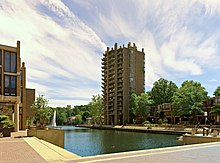William J. Conklin
[3] Conklin attended the Phillips Exeter Academy and, in 1944, he graduated with a degree in chemistry from Doane College, where he was the president of the student council.
[4] After completing his classes, instead of attending the graduation ceremony he immediately joined the United States Navy, serving as an electronics technician in the Pacific during World War II.
[17] He credited his long-time interest in historic textiles to his Nebraska grandmothers' tradition of quilt making; to the wife of a Doane professor who taught him to weave; and to his acquaintance with Junius Bird of the American Museum of Natural History in New York.
[4] He was as a research associate at the Institute of Andean Studies in Berkeley and at the Textile Museum in Washington D.C.[citation needed] Conklin formed ARC (Arts, Religion, and Contemporary Culture) in New York along with the mythologist Joseph Campbell, avant-garde artists Robert Motherwell and Ad Reinhardt, MOMA curator Alfred Barr Jr., literary critics Stanley Hoper and Amos Wilder, and psychiatrist Rollo May.
They later moved to Washington D.C. and bought a condo in the building overlooking the circular US Navy Memorial and the National Archive on the other side of Pennsylvania Avenue.
“This momentary action on your part could express your admiration of (and support for) the Founding American Documents, and also perhaps show your appreciation of the military,” Conklin wrote.
“Then you would return to your car and be on your way to the White House.” In the post-inauguration parade, despite elevated security concerns which called for a new highly armored limo, President Obama and the First Lady essentially followed Conklin's idea and walked a couple blocks in the frigid weather.

